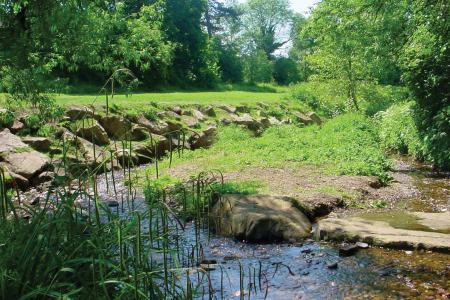Wombourne is an attractive village, steeped in history and a great destination for nature lovers and walkers.
It is thought Wombourne takes its name from two Old English words meaning ‘the winding stream’. The Wom Brook is a tributary of the River Smestow does indeed wind its way through the village and can be followed today along the Wom Brook Walk.
An award-winning wildlife-filled green route that crosses east-west through the village, Wom Brook Walk follows the path of the Wom Brook which gives the village its name.
By 1086, Wombourne was recorded as having a priest and two mills. A priest meant that there was already a church – which, according to legend, was built to give thanks to God for saving the village after skirmishes from marauding Danes, perhaps from the nearby Battle of Tettenhall in 910.
The settlement around the church grew very slowly centred around the home of the ‘lord of the manor’ who may well have lived on part of the green space now used as a sports field by the Cricket, Tennis and Bowls Club. This area remains the centre of the village today.
For most of its history Wombourne was an agricultural village, but industry began there unusually early. From the Middle Ages, the Smestow and Stour brooks which flow nearby were lined with small iron bloomeries using local charcoal and water.
Once the Staffordshire and Worcester Canal opened, iron ore could be brought from the Black Country and used in coke-filled furnaces.
The much-visited Bratch Locks are a stunning feat of 18th century engineering, comprising a staircase of three canal locks and toll house. Built of mellow local brick, they are a well-preserved example of Georgian life along the canal.
Bratch Pumping Station, known by many as ‘Wombourne’s Fairytale Castle’, with its ornate pinnacles is a notable Victorian landmark nearby.
For a few years from 1925, the Great Western Railway carried passengers from Wombourne and then goods traffic until 1965. It is now another way of crossing Wombourne as a railway walk in a natural setting. The South Staffordshire Railway Walk is a popular route ideal for cyclists, dog walkers and ramblers with its own Platform Café based in the old village railway station.
The Orton Hills are also a key location, covering the area between Penn and Wombourne. These hills offer super views of the Malverns, Woodbury and Abberley, Clee Hills, Baggeridge Ridge, and Clent Hills. Of triassic age, they are made up of bright red sandstones.
Families taking another popular walk off Showell Lane to the north are invited to ‘spot the plastic tree’. In winter the tree, which is really a well-disguised communications mast, is easy to distinguish from its leafless companions - but in summer requires serious concentration.
Wombourne Leisure Centre on Ounsdale Road, meanwhile, boasts a modern gym, swimming pool, a wide range of exercise classes and more – and has seen generations learn to swim, play sport, relax and get fit on its grounds.
